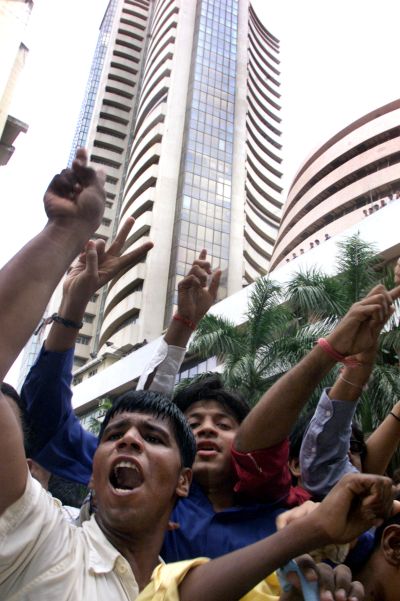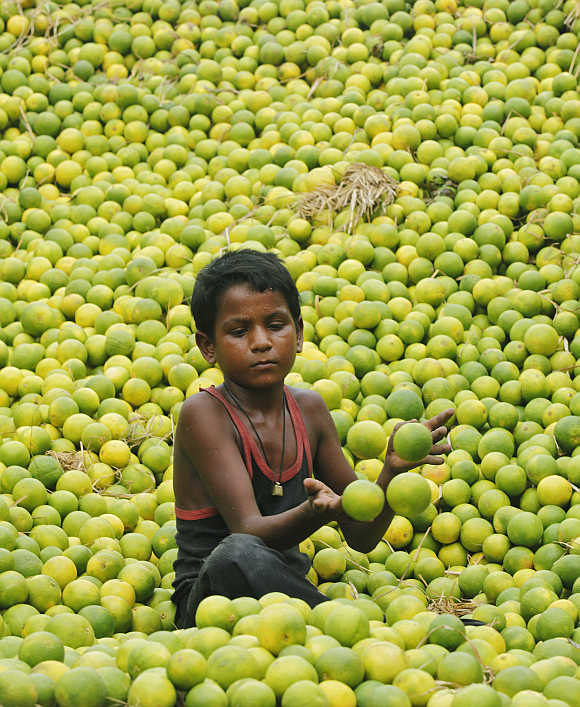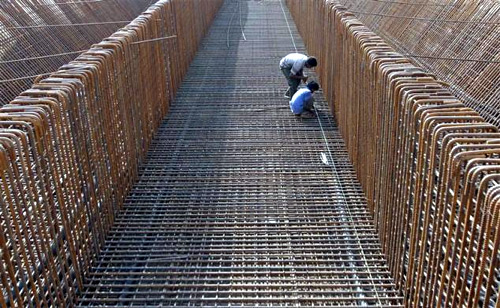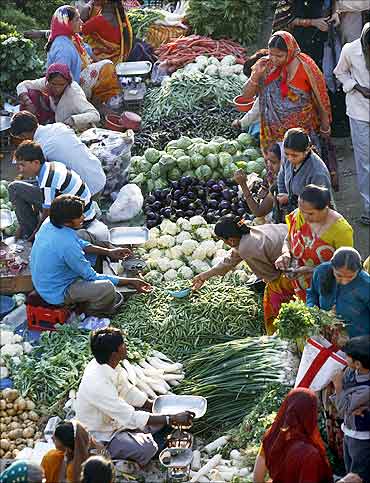Photographs: Jayanta Shaw/Reuters Subir Roy
By all accounts, India’s poor mostly in rural areas, can look back to a 10-year period when their lot clearly improved, says Subir Roy.
The dominant theme in the pre-election discourse is that misrule by the United Progressive Alliance (UPA) in its second term has led to sharply lower growth of gross domestic product (GDP), which Narendra Modi will reverse, the way he has made Gujarat shine.
But the evidence on hand does not support this correlation between the quality of national political leadership and growth performance. If anything, there is a close correlation between India’s growth story and global economic conditions.
In the two five-year periods during 2004-2013 corresponding to UPA-I and UPA-II, India’s average rank in GDP growth among BRIC countries, South Africa and Indonesia has remained the same.
It has been mostly second to China in the first five years, and mostly third after China and Indonesia in the next five years.
...
UPA rule: The poor never had it so good
Photographs: Reuters
Indonesia did better in the latter period compared to the first, whereas India did better during the first (UPA-I) compared to the second (UPA-II) - in keeping with the global economy, which boomed till the 2008 global financial crisis and then crashed.
Hence, it seems stellar growth, of the UPA-I type, is more dependent on what is happening to the global economy than on who rules India or how.
The current upsurge in the stock market and the value of the rupee illustrates how relatively small inflows cannot just affect investor sentiment but also deeply impact the overall economic situation through the value of the rupee and, consequently, exports performance and the current account deficit.
...
UPA rule: The poor never had it so good
Photographs: Reuters.
In contrast, where domestic policy and leadership do matter is in how the fruits of growth are distributed. By all accounts, India’s poor, mostly in rural areas, can look back to a 10-year period when their lot clearly improved.
A range of experts say this, making it a dominant theme. Even as casual wages increased rapidly and led to a key structural change, people moved out of farms into other employment - as a result, there has been a rise in farm output per worker.
For the first time ever, the number of farm workers in India declined during UPA rule.
Those leaving farms became construction workers, which was made possible by both infrastructure projects and housing, the two sectors in which they earned more. In the rural economy, a floor was put on wages through the national employment guarantee programme.
A fascinating structural change resulting from higher wages, in town and country alike, is that fewer girls are going to work on farms or elsewhere and there has been a sharp rise in the number of girls going to school.
...
UPA rule: The poor never had it so good
Photographs: Reuters.
Under UPA rule, for the first time in decades, the number – and not just the proportion – of the poor in India actually fell.
As Ajit K Ghose has pointed out in these pages, between 2000 and 2012, the share of formal wage employees and those in the organised sector rose, while the share of casual wage employees fell among all wage employees.
During the period, real output per worker in the unorganised sector rose sharply, as did real consumption expenditure by the self-employed. The real wages of casual employees rose sharply and the rate of under-employment among them also fell sharply.
If the poor never had it so good, why are they not rooting for continuity? One answer is: we don’t know their mind. In the run-up to the 2004 elections, everybody was thought to be rooting for a shining India!
...
UPA rule: The poor never had it so good
Photographs: Reuters
What can be said with certainty is that two fundamental issues always weigh with the poor over all else — the desire to live in peace (without the fear of danga) and not be ravaged by inflation (mehngai).
People in western Uttar Pradesh will certainly be influenced by the recent riots, as people are everywhere by high inflation.
But the irony is that it is the poor who are in a way responsible. They have had more to spend, which has taken food prices up sharply and resulted in the inflationary bout.
Obvious policy implications follow from this. There has to be a steady rise in the output of food and low-end consumer goods, as also the supply of housing, education and health care for the poor if transfers to them are not to result in high inflation.
...
UPA rule: The poor never had it so good
Photographs: Reuters
While domestic policy can take care of some of the supply side, it is high overall growth that ensures rising wages for non-farm employment through jobs in construction.
As we have seen earlier, this is in good bit in the hands of the global economy.
The poor have not done all that well under Narendra Modi in Gujarat, but industry and infrastructure have.
If you look at the whole country, it is Tamil Nadu that has done justice to both under the rule of both the major Dravidian parties, though both structures are hugely corrupt.
Can we have for the whole country the Tamil Nadu model without its leaders? And can we have stock market and business confidence without volatile short-term capital flows?








article